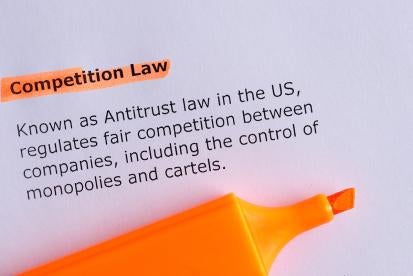The Federal Trade Commission (FTC), with the concurrence of the U.S. Department of Justice Antitrust Division (DOJ), has proposed widespread changes to the U.S. premerger notification form (Form) and its associated rules under the Hart-Scott-Rodino Antitrust Improvements Act of 1976, as amended (HSR Act).1 The HSR Act requires that, subject to applicable exemptions, mergers or acquisitions, including minority acquisitions, that exceed a minimum jurisdictional threshold value (currently $111.4 million, which amount is adjusted annually) and size of the deal parties, be reported to the FTC and the DOJ (the Agencies), and that a waiting period be observed, prior to closing.
The Agencies officially published the proposed changes in a Notice of Proposed Rulemaking (NPRM) June 29, 2023. The proposed changes consist of many significant additions to the HSR form's requirements, and very few deletions. If adopted (which is likely) the new reporting data and information framework will add significant time and cost burdens to all deals, including those having no substantive competitive impact. The Agencies themselves estimate a four-fold increase in HSR Form preparation time, and many HSR experts forecast an exponentially greater burden, when considering the full scope of efforts required to full comply with the additional requirements, especially those that are novel. While the Agencies have updated the Form numerous times over the years, having made minor revisions, the NPRM represents the most comprehensive overhaul and expansion of Form requirements in the history of the HSR Act.
Overall, the breadth of new requests included in the NPRM reflects recent commentary from the regulators on areas of antitrust enforcement they believe have been either overlooked or misunderstood and therefore need a renewed focus, such as “vertical” transactions between suppliers and customers, “roll-up” acquisition strategies, acquisitions backed by private equity, acquisitions of nascent competitors, effect on competition for skilled labor and free movement of that labor, and corporate interlocking directorates. But the NPRM also reflects an overall skepticism of acquisitions, perhaps with the end goal of discouraging them. As FTC Chair Lina Khan stated a few months ago: “There's a preference embedded in the laws that Congress passed, and in the ways that courts have interpreted them, that really express a preference for building over buying.”2
The NPRM notes as justification for the additional burdens on filing parties that, compared to the current HSR filing form, “most international jurisdictions have merger filing forms that ask filers to provide significantly more information.” However, in the European Union, transactions involving parties who self-report overlaps with small combined market shares may submit a “short form.” In contrast, the current proposals to overhaul the HSR Form do not account for the degree to which parties overlap and dispense with unnecessary screening information accordingly, but instead require all parties to provide a fulsome response to all items of the Form, regardless of potential competitive impact of the proposed transaction, essentially treating in the initial investigation phase all competitive overlaps between the transaction parties equally, regardless of either their nature or magnitude.
Further, while most jurisdictions require some form of narrative reporting by parties as to their market presence, they do not also require extensive document production. The NPRM would require both.
It is important to note that this NPRM does not expand the scope of transactions which would be subject to HSR Act reporting obligations, as a NPRM issued by the agencies in September of 2020 aimed to accomplish.
Among the most impactful categories of additional requirements to potentially be imposed on filing parties are the following:
-
Parties must submit a “draft agreement or term sheet that describes with sufficient detail the scope of the entire transaction that will be consummated” and provide considerable detail on minority investors and other “entities or individuals that may have material influence on the management or operations” of the acquiring entity, which will hinder if not prohibit the practice of filing a HSR Form early in a deal process on the basis of a letter of intent. Given the fact that deal structures typically are revised during the negotiation process, this requirement may make the deal negotiation process more constrained.
-
Given the breadth of the proposed Form changes, parties will need substantial additional lead time to prepare complete Forms, i.e., longer than the usual five (5) or ten (10) business days. This may require commencement of the HSR filing preparation well before a definitive deal is agreed to by the parties, risking incurring significant upfront costs that may be wasteful because deal negotiations end up being derailed.
-
The complexity of the proposed changes substantially increases the risk that a Form could be deemed incomplete and rejected several days post-filing, which would re-start the waiting period. Unlike in many foreign jurisdictions with significant upfront filing requirements, there is no “pre-filing” procedure to ensure completeness and thereby ensure that the waiting period will run as anticipated.
-
Parties must, at the initial stage of filing the HSR Form, take substantive positions on the market definition (often a critical component of the antitrust analysis) and the extent to which the parties compete or may be vertically related, which positions could be difficult to refine or modify at later stages of review or in litigation. In addition, this will require significant upfront due diligence on substantive competition analysis issues, incurring the time of advisors (attorneys and economists) as well as senior management of the deal parties.
-
The expanded scope of ordinary course strategic and transaction-specific documents may require labor-intensive custodial searches of numerous employees, as well as the use of outside vendors typically hired to assist with Second Requests, in order to ensure a complete production. This will add significant additional time and expense (document search, collection, review, and analysis) to the HSR filing process.
-
The Form would require an affirmative obligation to preserve documents and an explanation of messaging, communications, and collaboration apps used by custodians that would be covered by such an obligation. This type of certification is typically only required at the stage of a Second Request. It also risks the broadening of required disclosure of deal pendency to an expanded list of company personnel in the deal parties.
These and the other new obligations imposed by the expanded Form described in the NPRM are discussed in greater detail below. The Agencies announced that they will be accepting comments on the NPRM until August 28, 2023.
Additional Data and Information Sought
The proposed changes seek various additional data and information above and beyond what is currently required, including narrative descriptions of strategic rationales, competitive overlaps and supplier/customer or other business relationships between the filing parties, corporate structure and board information, expanded listings of minority investors and other “entities or individuals that may have material influence on the management or operations” of the acquirer, labor market information, information about connections to foreign jurisdictions and defense contracts, more expansive disclosures of prior acquisitions, and more extensive requests for documents relating to the transaction, as well as certain categories of ordinary course materials.
-
Competitive Strategy, Product and Market Information, and Customer and Supplier Relationships
Under the new framework, filers would be required to submit narrative responses detailing their competitive strategy, overlapping product(s), and relevant market information.
Strategic Rationale
Filers would need to describe in narrative form, all strategic rationales for the transaction, including, for example, those related to competition for current or known planned products or services that would or could compete with a current or known planned product or service of the other reporting person in the transaction, expansion into new markets, hiring the sellers’ employees (so-called acqui-hires), obtaining certain intellectual property, or integrating certain assets into new or existing products, services or offerings.
To help ensure that the provided narrative is grounded in the filer’s ordinary course documents, the Commission also proposes that the filer be required to identify which documents submitted with the HSR Filing support the rationale(s) described in the narrative.
Overlapping Product, Customer, and Supplier Relationships
Filers would also be required to describe their basic business lines and provide product or service information for all related entities, identify products or services that currently or are in development and may compete with those of the other filer in the transaction, identify existing or potential supply relationships between the filing persons (i.e., one party supplies a competitor of the other); and provide information about their employees and what services these employees provide.
For each overlapping product or service, the filing person would have to provide additional information including: (1) the sales for each of the past two fiscal years (or projected revenue and volumes of products to be sold), or any other metric by which the filing person measures performance (e.g., daily users, new signups), (2) a description of all categories of customers (e.g., retailer, distributor, broker, government, military, educational, national account, local account, commercial, residential, or institutional), and an estimate of how much of the product or service each customer category purchased or used monthly for the last fiscal year, (3) contact information for the top 10 customers in the last fiscal year (as measured in both units and dollars), and the top 10 customers for each customer category identified, and (4) a description of any licensing arrangements, and (5) a description, including duration, of any noncompete or nonsolicitation agreement applicable to employees or business units related to the product or service. If the overlapping product or service is in development and no customers have yet used it, other information will need to be provided such as the date that product development began, a description of the current stage in development, the date that development (including testing and regulatory approvals) was or will be completed; and the date that the product or service is expected to be sold or otherwise commercially launched.
Filers will have to list and describe each product, service, or asset (including data) that the filing person has sold, licensed, or otherwise supplied in the last two fiscal years to the other party, or to any other business that, to the filing person’s knowledge or belief, uses its product, service, or asset to compete with the other party’s products or services, or as an input for a product or service that competes or is intended to compete with the other party’s products or services. For each such product, service, or asset listed, filers will also then have to provide the amount of sales for each of the past two fiscal years, separately to (1) the other party and (2) any other business that, to the filing person’s knowledge or belief, uses its product, service, or asset to compete with the other party’s products or services, or as an input for a product or service that competes or is intended to compete with the other party’s products or services.
For these products, services, or assets, filers would be required to provide a list of the top 10 customers (as measured in both units and dollars) for their product or service, their contact information (including title, phone, and email) and a description of the relevant supply or licensing agreement (or other comparable terms of supply). Filers would also have to list the top 10 suppliers with contact information (including title, phone, and email) and a description of the relevant purchase or licensing agreement (or other comparable terms of purchase) with respect to these products or services.
-
Corporate Structures and Board Information
Limited Partners and Other Entities That May Have a “Material Influence”
Particularly notable for the private equity space, under the new regime filers would have to identify the 5% or more Limited Partners (LP's) at each level of an investment structure (current requirements are only 5% holders of the direct acquiring entity with no requirement to list 5% LPs, only the General Partner). The acquiring person would have to identify certain individuals (other than employees of the acquiring person) or entities that, in relation to the acquiring entity or any entity it directly or indirectly controls or is controlled by, (i) provide credit; (ii) hold non-voting securities, options, or warrants; (iii) are board members or board observers, or have nomination rights for board members or board observers; or (iv) have agreements to manage entities related to the transaction. Credit relationships would be limited to creditors that have, or would have, in conjunction with or as a result of the transaction, provided credit totaling 10% or more of the value of the entity in question. Holders of nonvoting securities, warrants, or options would be limited to those the value of which equals or exceeds 10% of the entity or could be converted to 10% or more of the voting securities or non-corporate interests of the company. The NPRM does not address the common scenarios wherein sources of funding or governance rights are not finalized until shortly before a closing or shift due to negotiations conducted between the date on which the HSR waiting period expires and the transaction is completed.
For transactions where a fund or master limited partnership is the ultimate parent entity, filers would also have to provide an organizational chart sufficient to identify and show the relationship of all entities that are affiliates or associates (i.e. those under the same investment management, but not within the same filing person).
Specific Board Members/Interlocking Directorates
Filers would also be required to identify officers, directors, or board observers (or in the case of unincorporated entities, individuals exercising similar functions) of all entities within the acquiring person and acquired entity, and identify what other boards on which these persons currently sit, or on which they have served, within the two years prior to filing. This information request is aimed at identifying potential violations of Sections 7 and 8 of the Clayton Act which prohibit interlocking directorates and generally the exchange of competitively sensitive information that such interlocks are alleged to facilitate.
The Commission also proposes requiring the same information for the prospective officers, directors, or board observers of the acquired and acquiring entities after the transaction, as well as for any officers, directors, or board observers of new entities created as a result of the transaction (and, in each case, for unincorporated entities, individuals serving those functions). If those individuals cannot be identified as of the filing date, filers would we required to list who would have the authority to choose them.
-
Labor/Employees
Overlapping Labor Market Information
To establish which types of employees the parties have in common and within which geographies, the HSR form would now require information about Economic Research Service Commuting Zone(s) from which the employees commute and the total number of employees within each commuting zone. This proposed requirement would be limited to overlapping geographies. Such data would need to be submitted using the Department of Agriculture’s Economic Research Service Commuting Zones for the year 2000. Filers would also have to provide labor data by using the first six digits of the relevant Standard Occupational Classification code, as published by the United States Bureau of Labor Statistics.
Disclosure of DOL, NLRB and OSHA Penalties
Filers would additionally have to identify any penalties or findings that were issued against the acquiring person or acquired entity by the U.S. Department of Labor’s Wage and Hour Division, the National Labor Relations Board, or the Occupational Safety and Health Administration within the five-year period before the filing.
-
Revenue Reporting, Geographic Market Information, and Prior Acquisitions
Filers will still have to use six-digit NAICS codes to classify their products. However, instead of providing precise revenue broken down by NAICS code, filers will have to state which of five revenue ranges apply to each code. Filers will also have to report NAICS codes for certain pipeline or pre-revenue products if they overlap with the other party to the transaction. Where the parties have overlapping NAICS codes, they will have to: (i) provide the name(s) by which entities have done business within the last three years, (ii) identify the overlapping entity within the filer’s own person, rather than the other filing person, (iii) identify locations of franchisees for certain NAICS codes, and (iv) provide geolocation data (in a new section titled Geographic Market Information).
Filers will also have to provide information regarding acquisitions they made in prior in the past 10 years (the current requirement is that this information be provided for the prior five years) regardless of the revenue threshold. This will mean that information regarding startups not meeting the current revenue thresholds for disclosure would now be captured.
With respect to the NPRM’s new revenue reporting and prior acquisition requirements, while acknowledging that NAICS codes are “imprecise” and “can result in underreporting of horizontal overlaps,” the proposals do not consider the opposite effect that reliance on NAICS codes can produce an inaccurate reporting of business overlaps solely based on NAICS codes, but which businesses do not actually offer substitutable products or services. While the proposed horizontal overlap narrative section (described in the Overlapping Product, Customer, and Supplier Relationships section above) requires the parties to self-report current or planned principal categories of products and services, the proposed Geographic Market Information and Prior Acquisitions sections continue to rely on NAICS codes as the functional equivalent of a competitive overlap.
Consider a private equity firm focused on investments in businesses which provide software solutions. The group of funds to which the filing party belongs may investment in dozens of businesses which do not at all compete with the other party, but which would report revenue in the same generic NAICS code. The result here may be that the filing party may be required to report geographic information for numerous businesses and perhaps a lengthy list of prior acquisitions which have no incremental probative value to the Horizontal Overlap Narrative section. Reporting this additional information would compel the agency staff to broaden its investigation in an inefficient manner to understand why this additional information was reported to confirm that it does not cause anticompetitive concern.
-
Additional Documents Sought
The proposed changes seek various additional documents, significantly adding to the burden of document review and production associated with making an HSR filing. They also add to the risk of raising red flags through concerning statements that may be made in documents turned over to the Agencies.
Draft Deal Documents (if finalized documents are not available)
Under the new rules, filers will no longer be permitted to file based solely on a bare-bones Letter of Intent or sparse Term Sheet. They will need to provide a detailed “sheet or draft agreement that reflects sufficient detail about the proposed transaction to allow the Agencies to understand the scope of the transaction and to confirm that the transaction is more than hypothetical.”
All Agreements Related to the Transaction
The new framework would require filing persons to produce all agreements, inclusive of schedules, exhibits, and the like, that relate to the transaction, regardless of whether both parties to the transaction are signatories, and other agreements negotiated with key employees, suppliers, or customers in conjunction with the transaction, all agreements between any entity within the acquiring person and any entity within the acquired person in effect at the time of filing or within the year prior to the date of filing.
The Commission’s stated goal is to understand any business interactions or relationships that exist prior to the transaction and that may be affecting premerger competition, so documents required could include licensing agreements, supply agreements, noncompetition or nonsolicitation agreements, purchase agreements, distribution agreements, or franchise agreements.
Verbatim English Translations
All non-English language documents will have to be translated into English. A particular method of translation is not specified, but the resulting translations will have to be verbatim, understandable, accurate, and complete.
Draft of Transaction-Specific Strategy Documents
Drafts of transaction-specific documents (the so-called Item 4(c) and 4(d) documents required under the current Form) would have to be included if the draft documents were provided to an officer, director, or “supervisory deal team lead,” functionally a person who coordinates the day-to-day process for the transaction at issue who may not be an officer or director. As explained in the NPRM, a supervisory deal team lead need not have ultimate decision-making authority, but would have responsibility for preparing or supervising the assessment of the transaction and be involved in communicating with the individuals, such as officers or directors, that have the authority to authorize the transaction.
Ordinary Course Strategic Plans in Overlap Markets
Filers would also need to provide ordinary course strategic plans in overlap markets, semi-annual and quarterly plans and reports that discuss market shares, competition, competitors, or markets of any product or service that is provided by both parties to the transaction, if those documents were shared with a chief executive of an entity involved in the transaction, or with certain individuals who report directly to a chief executive or board. This requirement would be limited to documents created one year prior to the filing. Filers would need to document exactly who was searched for responsive documents and their roles within the organization of the filing party.
This document requirement would exclude individuals responsible solely for environmental, tax, human resources, pensions, benefits, ERISA, or OSHA issues.
-
Connections to Foreign Jurisdictions and Defense Contracts
Governments of Concern: Subsidies and Countervailing Duties
Under the new framework, filers would have to disclose (1) subsidies (i.e., grants and loans) from countries or entities that are considered to be economic or strategic threats to the U.S. (as defined by 42 U.S.C. 18741(a)(5)(C)), currently including Russia, North Korea, Iran, and China, and (2) any products produced in any such country that are: (a) subject to countervailing duties (i.e. “duties intended to offset the price effect of significant foreign government subsidies on a product or good”), or (b) the subject of an investigation by any jurisdiction for potential countervailing duties (limited to knowledge or belief). These additions are based on the passage of the Merger Filing Fee Modernization Act of 2022.
Other Jurisdictions Filed
Filers would also have to identify the ex-U.S. jurisdictions in which each filing person has already filed or is preparing notifications to be filed for the transaction, as well as the jurisdictions where it has a good faith belief it will file voluntary waivers to allow U.S. federal regulators to coordinate with state and foreign enforcers.
Defense Contracts
Additionally, both the acquiring and acquired persons will have to identify whether they have existing or pending defense or intelligence procurement contracts, as defined by 10 U.S.C. 101(a)(6) and 50 U.S.C. 3033(4), valued at $10 million or more, and provide identifying information about the award and relevant DoD or intelligence community (IC) personnel.
-
Updated Pull-and-Refile Procedures
A few changes are proposed to the “pull-and-refile” requirements. In the event of a pull-and-refile, the set of Item 4(c) and 4(d) documents will need to be updated to reflect any additional documents created in the interim. The Commission also proposes adding the requirements that the refiled application must include updated transaction agreements and updated information about subsidies from Foreign Entities of Concern (described above).
-
Additional Certifications
As noted above, filing persons will need to certify that they have taken steps to prevent destruction of relevant information, including identifying messaging and collaboration apps covered.
* * *
The Agencies’ proposed changes to the Form requirements contained in this NPRM will not go into effect for several months and will not impact deals in the near term. First, as noted above, the NPRM is subject to the public comment period which will expire on August 28, 2023. The Agencies will then consider any modifications resulting from comments received and a revised version must undergo further administrative review. Once final, the new requirements may also be challenged in court.
1 15 U.S.C. § 18a.
2 See FTC's Khan Says Antitrust Laws Favor 'Building Over Buying’ (April 26, 2023).





 i
i


